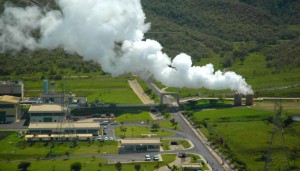
Geothermal energy is among renewable energy sources. It is derived from natural steam generated by heat deep in the earth’s crust, especially from volcanic-active belts.
The Great Rift Valley transverse Kenya from the north to the south. It is an area known for extinct, latent and active volcanic activity. This makes it an ideal location for generating geothermal energy.
The Olkaria area is a region located in Kenya’s Rift Valley. It is home to the largest geothermal project in Africa. It has been used to generate clean geothermal electrical power. It is estimated that the Olkaria area has a total potential of 2,000 MW, which is almost equivalent to current electricity demand in Kenya.
The Olkaria I commercial electricity generation started in 1981 with 15 MW. Similar capacity generation was added in 1982 and 1985 to make a total output of 45 MW. There was a steady increase over the years. At the end of 2014, an additional 140 MW was added to the national grid to make a total of 280 MW.
In the first half of 2015, Kenya imported 27.97 million kWh of electricity from Ethiopia (~5%) and Uganda (~95%). This is a drop of 29.94 million kWh compared to a similar period in 2014. The additional 140 MW increase in electrical energy added to the national power grid by Olkaria 1 geothermal power plant necessitated a sharp slump in power imports by 51.7%. This has also resulted in a fall in power bills to its customers.
This is good news for East Africa’s largest economy. This follows a rise in energy demand from the growing industries and increased electrical connectivity to its citizens which is now roughly 37% of the total population. This is against Kenya’s ambitious plan to connect 70% of its population to the electric power grid by 2017.
One thought on “Geothermal Energy Cuts Kenya’s Electrical Power Imports by Half”